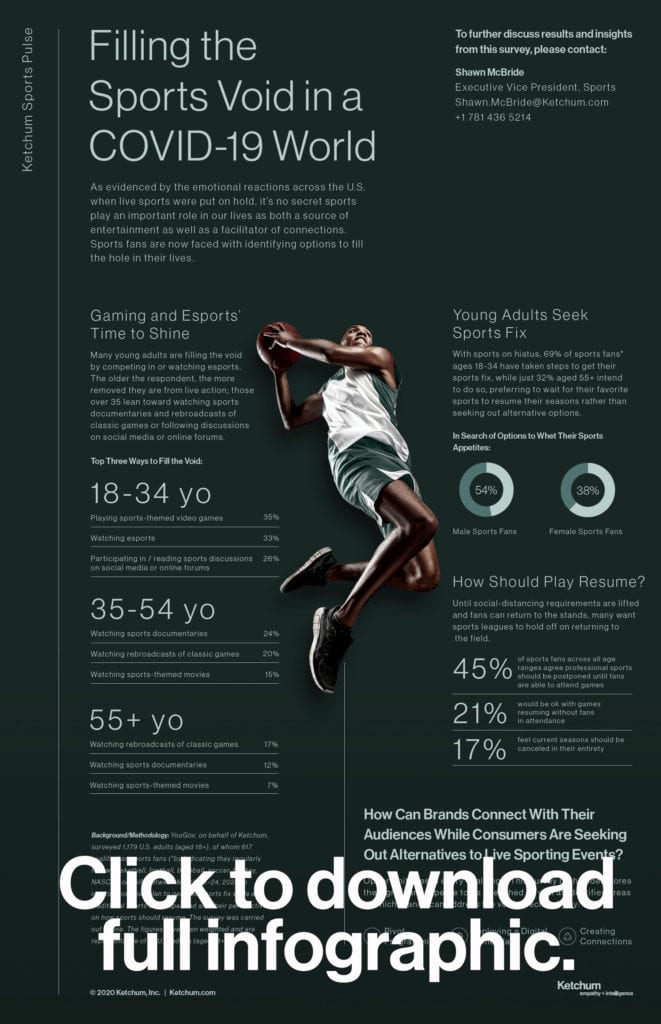Normally at this time of year, U.S. sports fans would be filled with hope related to their favorite MLB team’s prospects for the 2020 season, preparing for the start of the NBA and NHL playoffs and speculating about the rookies their football team will be selecting in the upcoming NFL Draft.

But these aren’t normal times. The emotional reactions across the U.S. when live sports were put on hold show the important role they play in our lives, both as sources of entertainment and creators of community. How are sports fans filling this hole?
Ketchum Sports recently surveyed fans to understand their mindset during these uncertain times. We focused on where they are looking to get their sports fix and how they want sports to resume when the time is right. Based on their answers, here are the new rules of engagement for brands during this time.
 Among sports fans ages 18-34, 69% have taken steps to get their sports fix. Conversely, just 32% age 55+ have done so, indicating they may prefer to wait for their favorite sports to resume their seasons rather than seek out alternative options. It appears that traditional lifelong consumption behaviors might be engrained in older sports fans, who are putting their fandom on pause during the hiatus.
Among sports fans ages 18-34, 69% have taken steps to get their sports fix. Conversely, just 32% age 55+ have done so, indicating they may prefer to wait for their favorite sports to resume their seasons rather than seek out alternative options. It appears that traditional lifelong consumption behaviors might be engrained in older sports fans, who are putting their fandom on pause during the hiatus.
Gaming and Esports’ Time to Shine
How is that 18-34 group filling the void? By playing sports-themed video games or watching esports, which in recent years has been the biggest competitive entertainment magnet for this audience’s attention. With most of the leading properties continuing their seasons at present, it’s natural to expect fans to either further engrain themselves into the culture or, for those who hadn’t fully immersed themselves, to more deeply explore it.
Esportsification
One trend that has generated rapid momentum in the early weeks of quarantine is essentially the “esportsifying” of traditional sports, with many properties, from motorsports to basketball to football, briskly producing digital programming that blends the virtual with the real to engage and entertain fans. In the current sports desert, these competitions have been embraced by fans who might otherwise have brushed them off as novelties. An intriguing question is whether these highly realistic alternatives will drop off when it is safe to return to the grandstand, or whether some could remain as complementary programming to main events or competitive content to fill off-season calendars.
Meaning Through Nostalgia
Meanwhile, respondents over the age of 35 are leaning toward watching sports documentaries, rebroadcasts of classic games or sports-themed movies to get their fix. All across the sports landscape, content vaults have been opened to fill the broadcast slots that would have otherwise been occupied by current competitions with this type of historic content, which serves as comfort food, delivering an extra helping of dopamine via warm memories and reminders of happier times.
How Should Play Resume?
And now, the really big question … when returning to the field of play is deemed safe and feasible, how do fans want it to happen? The survey revealed that nearly half (45%) of fans want sports leagues to hold off a return to the field until they are able to attend games themselves. This is the a data set that has the potential to shift over time; the longer sports remain on hiatus, the more fans’ attitudes toward the ideal scenario—i.e., communing together by the thousands at our stadium of choice—may evolve to simply being happy to cheer on their favorite teams in fresh competition under any circumstance.
What Opportunities Exist for Brands?
Now more than ever, brands should use two tenets as their north star when leveraging sports to engage with consumers: be additive, and do no harm.
This should be pretty straightforward, but, as with most things, context is key. In this case, whatever marketing communications are deployed need to be done through a dual lens that expresses an abundance of compassion and features significant creativity.
Three considerations for brands in the current environment:
- Pivoting programming is a given. Existing game plans need to be put on the shelf, if not thrown out the window. From there, gain an understanding of how sponsorship assets and inventory can be utilized to engage with audiences in a meaningful manner, whether you seek to support or entertain. Relatedly, listening to and understanding the shifting environment is critical to ensuring appropriate activations.
- Digital needs to lead. For the foreseeable future, digital will be at the center of the fan experience. Sports fans are a highly engaged audience, so brands need to identify ways to interact with them while supporting their interests and fueling their passions. Being the brand that delivers the enhanced experience will result in in share of heart as well as share of mind—which in sports marketing historically has equated to share of wallet, too.
- Create connections to facilitate community. Sports fans are also inherently community-oriented. While everyone struggles with distancing directives, brands should strongly consider being a catalyst to support this element of the fan persona via ownable programming driven through interactive channels.
A brand that delivers unique, interesting and entertaining content can position itself to build deeper existing relationships with their current fans, and perhaps even add new ones. Brand sponsors have every right to expect property partners and content rights holders to collaborate in new, authentic and relevant ways. Like everything else these days, we are better together and will need to rely on each other to overcome the challenges before us.
I’d love to hear how you’re getting your sports fix or answer questions about ways your brand can pivot. Reach out.



